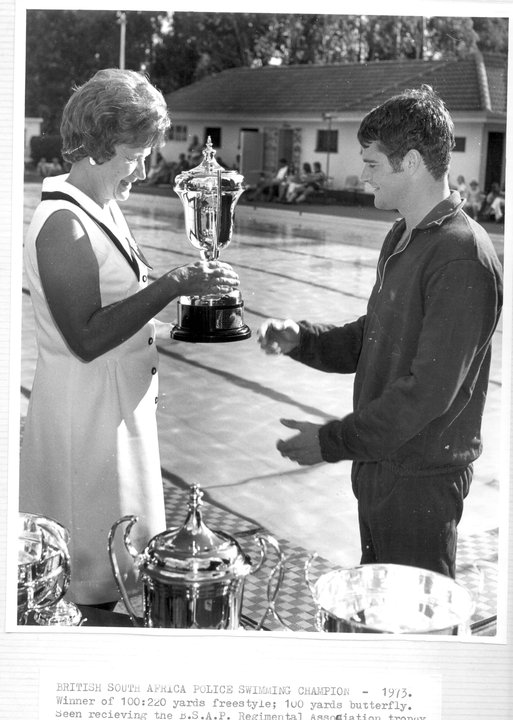Diving
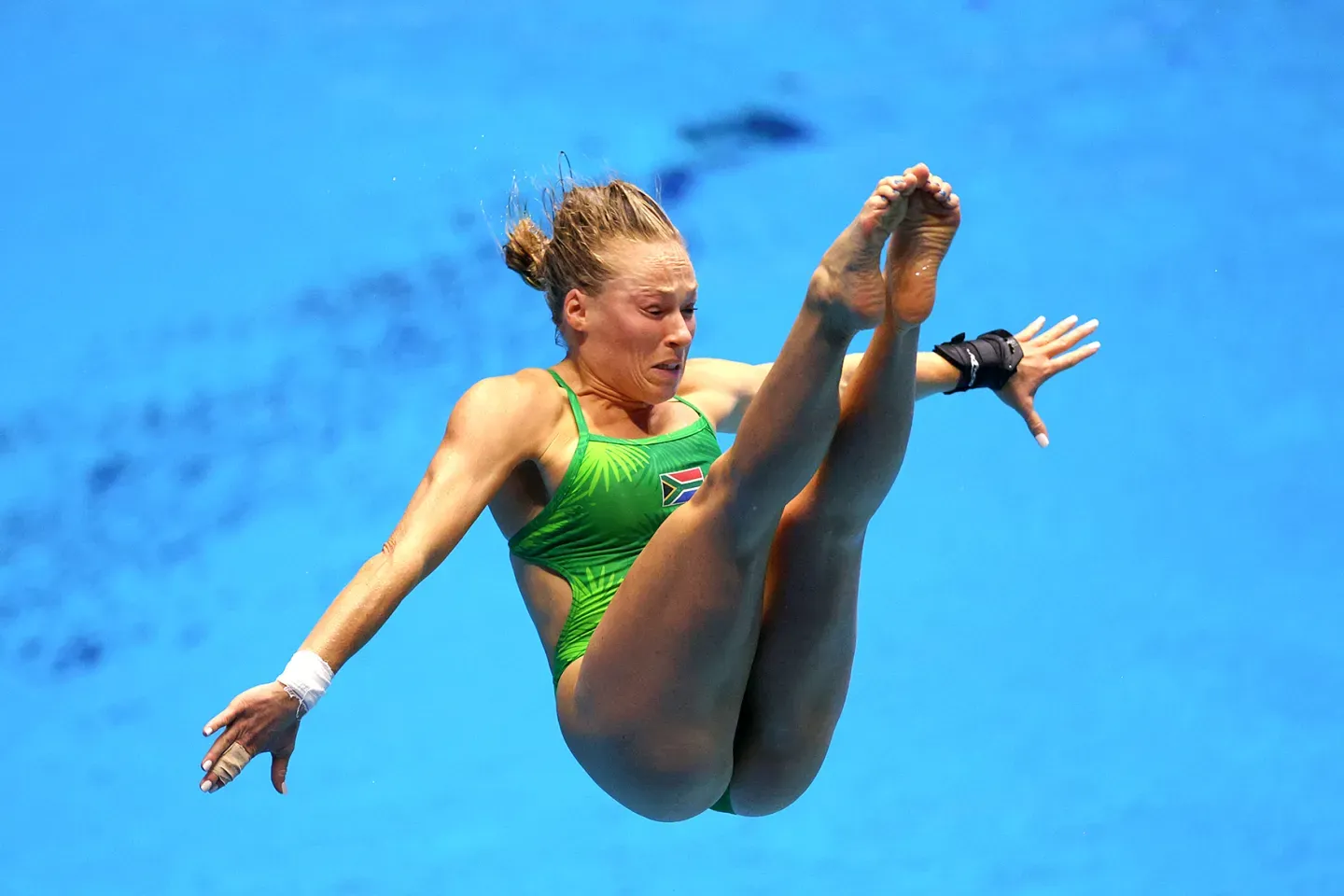
Julia Vincent of Team South Africa competes in the Women's 1m Springboard Preliminaries at the Fukuoka 2023 World Aquatics Championships at Fukuoka Prefectural Pool on 14 July 2023 in Japan. Paris 2024 was to be Vincent's final Olympics.
History of Diving in southern Africa
By Robert Michael MacLean
This study was carried out in partial fulfilment of the requirements of the B.A. Honours Degree in Physical Education, Rhodes University, Grahamstown, R.S.A., 1977.
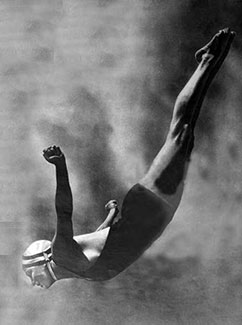
Oonagh Wittsitt - Gold Medal winner at the 1930 Empire Games
Springboard diving became a competitive sport in South Africa in 1922. In 1923, on the recommendation of a Mr Jimmy Green, a well-known South African swimming coach, an international-type springboard was imported from the USA and was installed at a swimming pool in Messina, Far Northern Transvaal. The following year, Green persuaded the Pretoria Municipality to import and install a similar board at their municipal baths. (It should be noted that England did not have an internationally recognized type of springboard until 1923 and so Green’s initiative would therefore seem to have opened the first chapter in the history of South African diving – though one cannot help but wonder why SA’s first ever international diving board should have been installed in Messina!
South Africa’s next step forward was the gaining of the F.I.N.A. Handbook containing the rules and regulations governing the sport at International competitions – notably, the Olympic Games – and this occurred in the mid-1920s. A study of these rules made plain the hitherto imperfectly understood things concerning diving technique and the manner in which diving competitions should be conducted.
Following the 1932 Olympic Games, in Los Angeles, USA, P.J. Grobbelaar, of the South African team and Manager of the 1932 SA team to these games, brought back from the United States films of the Olympic divers in action as well as plans of the actual equipment used in the competition. The difference between this equipment and the aforementioned boards (in Messina and Pretoria), lay in an improved type of movable forum, which increased the flexibility of the board. The University of the Witwatersrand (Wits), working to the specifications of the Los Angeles equipment, installed diving facilities at the university pool and ding found a permanent home in South Africa.
Following the 1936 Berlin Olympic Games, the Wits University swimming club imported a film on the mechanics of diving, showing the American, Harold Smith (Silver medallist, 1932 Olympic Games), in action. As this film was in slow-motion and covered all the dives contained in the (1936) diving tables of the F.I.N.A. Handbook, it provided an invaluable visual medium through which modern diving techniques could be studied and taught. Wits, using W. Bohlander, the 1940 SA diving champion, made a similar film, where Bohlander demonstrated his interpretation of Smith’s mechanics of springboard diving. This and the film of Smith was then used prior to teaching and coaching diving and divers, initially at the Wits pool and later, throughout South Africa, where they certainly stimulated interest in the sport.
With the collaboration between the Johannesburg Schools Amateur Swimming Association and the Wits Swimming Club (1946), diving at high school level on the Rand began to flourish and this found expression with the Diving Officials Courses of Instruction that was offered to school teachers who wished to become proficient in the teaching, coaching and judging of the sport.
December 1947 saw members of the Transvaal A.S.A. partake in a diving course, organised by Wits University S.C., which was the beginnings of a diving standardization programme for judging in South Africa. This was an important factor in the establishment of the sport proper, for, before this, the rules governing diving judging were not always fully understood, with the result that marks awarded sometimes varied within the competition to the point of being most unsatisfactory. (This still happens – a human failing no doubt – witness the discrepancy of 4.5 points between judges on Martin Lundie’s Reverse 2 ½ at the Durban National, 1976!).
However, with more qualified persons to their disposal, the provincial A.S.A. bodies were now able to go about conducting competitions with a high degree of efficiency. About this time, the Kingfisher Diving Club, the first diving club to be formed in South Africa, was established in Port Elizabeth and at the St. George’s Park Swimming Pool. Strongly backed by the Eastern Province A.S.A., from these early years, Kingfisher Club has turned out many exciting divers, several of them South African champions.
Top of their present list is Barry Birkett, present holder of the Men’s 1m diving title as well as being the 3m title holder in 1974 and 1975. Headed by some of South Africa’s top diving coaches and administrators such as John Pemberthy (himself a Rhodesian and Springbok diver), Peter Defferary (also Rhodesia and South Africa) and his wife Ursula, this club started out under the auspices of such well-known names to South African swimming sports as Alex Bulley, Rae Smit (nee’ Walker) and Geoff Mandy, the 1948 Olympic Games Springbok diver. This club, over the years, has and still does arrange diving competitions, courses and seminars for competitors and officials, in the continuing attempt to boost their sport in this country.
In the history of South African diving prior to 1950, only a few names come readily to mind, among them being H.W. Harris of Natal, F.A. Brandt, W, Bohlander and Cliff Lubbe of Transvaal, Geoff Mandy of the Eastern Province and Willie Welgemoed of Northern Transvaal. The same also holds for women’s diving. Very few women applied themselves to this sport in South Africa prior to the 1950’s although pride of place for these times goes to Oonagh Whitsitt, the 1930 gold medallist at the Empire Games of that year.
Geoff Mandy, who competed at the 1948 Olympic Games in London and who held the S.A. title from 1946 to 1949, was the first male diver from South Africa to represent his country overseas. During the 6 years he spent with the South African Forces during World War II, he had the opportunity of seeing and competing against the best divers in the world in the Middle East. He also has the honour of being selected to compete for the Mediterranean Area Team against The Rest of Europe during his army service. A fine sportsman and one was a real credit to this country in the diving world, Mandy lost his SA title to Willie Welgemoed in 1950, who was to become the next male South African diver to compete in the Olympic Games and that was in Helsinki in 1952.
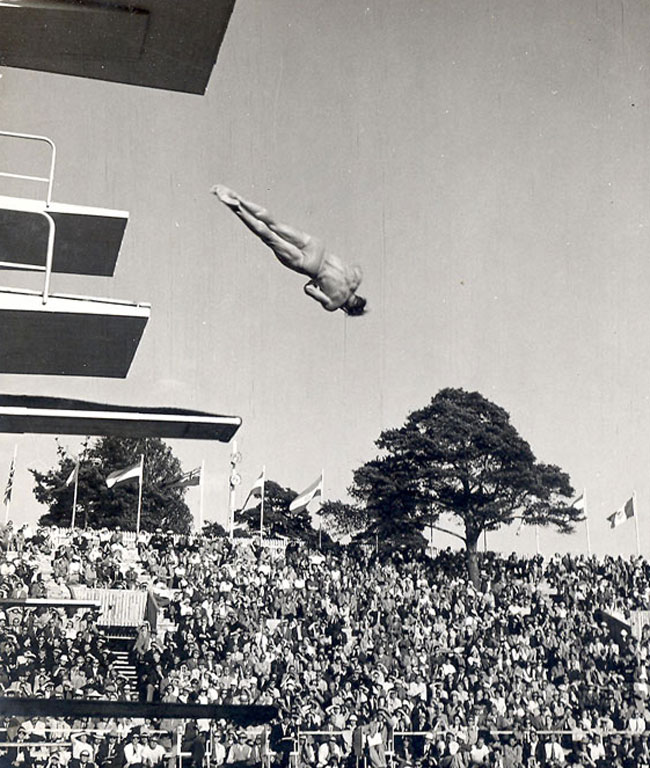
Willie Welgemoed at the 1952 Helsinki Olympic Games.
Welgemoed, who won the national title until 1955 (Basil Bowen won in ’54), had this written of him following his performance at the ’52 Games, by Mr SA Swimming, Alex Bulley, himself….”W. Welgemoed, Men’s springboard diving. 22nd place, 61.64 points. Welgemoed failed to qualify by 9 points on his first 6 dives. The Americans who took the first three laces were outstanding, but I felt that Welgemoed should have held his own with the other competitors. I think that Welgemoed put his best efforts into his final training practices and his failure to reproduce form in the competition was due to his nervous temperament”…..
During the 1950’s, men’s diving in South Africa was dominated by Welgemoed (N. Tvl), Basil Bowen (N. Tvl) and Tut Marwick (Natal), who represented South Africa at the 1958 Cardiff Empire Games. In women’s diving circles, P. Chapman of the Transvaal, W. Almond (also Tvl), S. Bands and Jean (nee’ Bands) Ward of Natal dominated.
The arrival of Sandra Morgenrood (below), Rhodesia, who won the women’s 3m title in 1959 was the beginning of a Rhodesian dominance of the diving scene in southern Africa, which still persists, broken only by the fact that Rhodesians no longer compete as official competitors at the SAASU National Championships, but as invited guests. However, a brief reference to the appendix will show that they still have the better of their South African opponents.
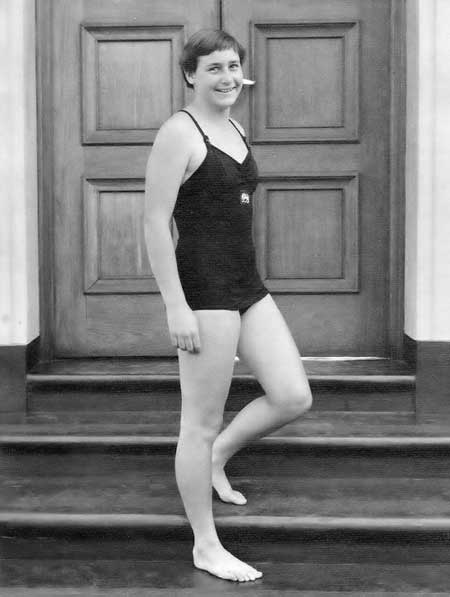
Sandy Morganrood - 1960 Rhodesian Olympic Diving Team Member, Rome
Prior to the 1950’s, Rhodesia had only produced one South African diving champion and that was Freddie Gibbs who won the title in 1929. The emergence of Rhodesia as a diving nation began with the advent of Ian Grace being selected to represent Rhodesia at the 1950 Empire Games. A forward-looking policy by administrators in the late ‘50’s saw a blossoming of this branch of aquatic sports in Rhodesia and by this time a solid cadre of coaches was very active in the country and in all ten major centres; to wit, Gordon Bridger and Chris Theodosiou in Bulawayo, Val Butler in Umtali and Pat Morgenrood and Ron Ward in Salisbury.
From this time onwards , Rhodesia became increasingly interested in diving and competition in the larger centres became keener with divers having to improve their techniques and degrees of difficulty to keep up with their opponents. Diving officials and coaches also had to improve their knowledge to keep in line and this naturally had a very positive effect upon the sport.
Without the keen interest of all these individuals, diving could never have progressed as it did. South Africa was behind in this respect for many years and this allowed Rhodesia to dominate the scene. However, having to take this ‘back-seat’, encouraged South African divers to improve their standards and this has certainly been evident in the 1970’s.
In 1973, several of South Africa’s top divers and well as budding potential champions, dissatisfied with how diving was being run in South Africa, broke away from the S.A. Amateur Swimming Union (SAASU) and led by a former national champion, Ernst de Jong, formed the South African Diving Union (SADU) with its headquarters in Pretoria. The reason for this breakaway, to quote de Jong, was to improve the lot of SA’s divers, who were getting a raw deal facilities-wise and international competition-wise, from SAASU.
Said de Jong….”we had our own diving centre cat New Muckleneuk in Pretoria; a pool 5 m deep with two 3m diving boards and four 1 m diving boards. My brother, Gerrie, built it out of his own pocket. When the National Film Board commissioned me to make an instructional film on diving, I had a ready-made set. I shot half the movie at New Muckleneuk, using Gina Lawrie and Robin Lieberman as the stars and the other half at the Rhodesian/South African International last year (1975). We arranged tests against the Rhodesians to give our divers an incentive. We designed our own Springbok colours (and badge) and awarded them to Gina Lawrie, Joe Thewliss and Martin Lundie for the first test.
We introduced group programmes so that juniors would not have to struggle against seniors as they did before. Having a union still didn’t bring us what we wanted most of all, the respect of the swimming officials. In fact, they showed less interest in us and we went on encountering poor facilities”…. De Jong kept SADU alive for two years; exasperating years when progress was an uphill task and when he disbanded SADU in late 1974, all that progress was nullified. ….”all the top divers, including the Rhodesians, quit the sport rather than going back to competing under SAASU. Today, diving is in a worse condition that it was before we launched SADU”…..
However, it seems that there was more to this breakaway besides poor facilities, but it is not my lot to argue one way or the other whether de Jong was right or wrong. What is apparent, is that he was (perhaps still is) intensely interested and keen on diving and what he did was what he thought was best for South African diving.
One this that must be countered though is in his last statement, for the Rhodesians did not quit and neither did at least two of his SADU stars, to wit, Martin Lundie who has since won his Springbok colours and is the current men’s 3m title holder and Joe Thewlis, who represented S.A. in the annual diving test match against Rhodesia this year. Added to this, S.A. Diving, under the leadership of men like John Penberthy, Peter Defferary and Vic Mijon, is on the ‘up’. Where the biggest problem exists, is in that area pointed out by de Jong – facilities.
Even though South Africa has a climate almost second to none in the world, indoor diving facilities with heated pools are need if divers are to compete at the highest level of international competition. That the talent is here is borne out by Ken Mullin’s statement on his return from the Montreal Olympics……”what a great pity it is that our top divers cannot participate at the Olympic Games. From what I saw during my visit to Montreal, they certainly would not have been embarrassed and would definitely not have finished last in the preliminaries”…… In other words, they would have been in the top twenty in the world – that is extremely encouraging.
A further important factor concerning diving in southern Africa was the break between Rhodesia and South Africa in 1972, which continues today (1977). With South Africa and subsequently Rhodesia, out of favour with F.I.N.A. for political reasons, it was decided to suspend Rhodesia from entering the S.A. National Championships as formal competitors and instead inaugurate annual test matches between the two countries in an attempt to at least meet some form of international competition.
At these tests, all four of the aquatic disciplines (diving, swimming, synchronized swimming and water polo) are contested and yet, apart from 1974, when Rhodesian divers did not attend the S.A. Nationals, they have dived regularly as invitees and have continued to rate tops in both the men’s and women’s events.
However, 1977 saw a strong S.A. side extend the Rhodesians, especially in the men’s events, when they took 2nd, 3rd and 4th places on both 1m and 3m boards. David Parrington, winning both the 1m and 3m contests, managed to salvage Rhodesia’s pride. In the women’s event though, Rhodesia again continued to dominate with Debbie Hill leading the way with her usual immaculate and imperturbable performances.
Ironically, her main opposition from South Africa was Lesley Smith, a former Rhodesian and South African Champion who was diving for South Africa by virtue of her student status in that country. 1959 saw the entry into the S.A. diving programme of a 1m championship. Such an event does not occur in major overseas contests where competition is limited to tower (10m) and 3m springboard.
However, in S.A., very few pools offer tower facilities and for this reason, S.A. diving has remained at a low level – equipment-wise! Since the inauguration of the 1m event, the Rhodesians have completely dominated, with Sandra Morgenrood beginning the Rhodesian women's run of victories in 1960, through to Debbie Hill in 1977 (unofficial of course, at S.A. national level) and Tony Steele, 1960, through to David Parrington for the men. In 1975 a handsome trophy for the 1m champion was presented and is named the Selwyn Hilton Katz Memorial Trophy. This trophy has been won on every occasion it has been contested (at the time of writing - 1977) by Barry Birkett of the Eastern Province.
A further reason for the continued Rhodesia diving excellence has been the fact that they have been able to ensure their divers of international competition through the years, in spite of world's political opinion and the laurels for this must be laid at the door of the Jester’s Club. This club consist of past and present Rhodesian champions and champion coaches, who have, through coaching clinics and membership fees, been able to sponsor (with the help of the Rhodesian Amateur Swimming Association – R.A.S.A), the visits of various overseas diving stars to Rhodesia, where they have dived competitively against Rhodesian’s, held coaching clinics and generally stimulated interest in the sport.
It is noted that S.A. is now doing the same thing, although this appears to be handled either through the Department of Sport or the Southern African Sports Foundation. It is hoped that this continues, for it can only be beneficial to divers in this country. It has already been stated that several South Africans, namely, Oonagh Whitsitt, Geoff Mandy, Willie Welgemod and Tut Marwik, have represented S.A. overseas in international contests. So too have the Rhodesians, beginning with Ian Grace in 1950. Amongst them was Lindsay Grant-Stuart, who won a bronze medal at the 1962 Empire Games and, with Terry Rossiter, represented Rhodesia at the Tokyo Olympic Games in 1964.
Perhaps the finest divers to have come out of Rhodesia have been the Lieberman cousins, Don and the late Robin, Sarie Bezuidenhout and Lena Woodard (nee’ Pretorius). The Liebermanns and Woodard were members of the ill-fated Rhodesian Olympic team that travelled to Munich in 1972 and were then denied the chance to compete because of the political line taken by so many other nations attending.
How they would have performed is pure speculation, because on the day there are many things that can go right or wrong, but it makes one think when one considers that the American, Ann Peterson, the bronze medallist of the Mexican Olympic Games of 1968, was given a torrid time in competition when she dived against both Bezuidenhout and Woodard in 1972.
Similarly, when the American, Craig Lincoln, the Munich ’72 bronze medallist visited Rhodesia in 1976, he was well beaten by Robin Lieberman. The critic might always say that the two examples quoted had several years behind them since their triumphs at different Olympiads, but this doesn’t alter the fact that this little country has had, and we hope will continue to have, immense diving talent.
Rounding off the international scene, the following Rhodesia divers have competed at the highest levels (excluding Olympic and Empire Games):-
1966 – Terry Rossiter – 2nd place, British Championships, 3m. 1966 – Lindsay Grant-Stuart, 2nd place, British Championships, 3m. 1972 – David Parrington, 3rd, World Age Group Championships, 3m.
Of further interest in S.A. diving circles was former Springbok Willie Welgemoed’s presentation of two beautiful Mexican sombreros to S.A. Diving, to be awarded to the men and women who score the highest number of points on any one dive during the S.A. National Diving Championships. These are floating trophies and since their inception in 1969, the following divers have won the trophies named, “Sombrero Willie” for the men and “Sombrero Ann Senorita’ for the women: -
Sombrero Willie. 1969, 1970, 1971 – Don Lieberman. 1972, 1973 – Robin Lieberman. 1974, 1975, 1976, 1977 – Barry Birkett. Sombrero Ann Senorita 1969, 1970 – Lena Pretorius 1970 – Dottie Armstrong 1971, 1972 – Lena Pretorius 1973 – Gina Lawrie 1974, 1975 – Elaine Parker 1976, 1977 – Debbie Vaughan.
S.A. Diving Champions – 3m Springboard – Men. 1922 – N.V. Oxenden 1923 – 1928 – H.V.Harris (Natal) 1929 – P.W. Gibbs (Rhodesia) 1930 – A.S. Alty (Natal) 1931 – H.E. Buckley (Western Province) 1932 – 1933 – F.A. Brandt (Transvaal) 1934 – 1939 – C. Lubbe (Transvaal) 1940 – W. Bohlander (Transvaal) No Championships during the war years, 1941 – 1945. 1946 – Goeff Mandy (Transvaal) 1947 – 1949 – Geoff Mandy (Eastern Province) 1950 – 1953 – Willie Welgemoed (Northern Transvaal) 1954 - B. Bowen (Northern Transvaal) 1955 – Willie Welgmoed (Northern Transvaal) 1956 – 1957 – B. Bowen (Northern Transvaal) 1958 – 1959 – C.T. Marwick (Natal) 1960 – Ernest de Jong (Northern Transvaal) 1961 – Tut Marwick (Natal) 1962 – 1963 – K.J. Mullen (Natal) 1964 – 1966 – T. Rossiter (Rhodesia) 1967 – 1968 - D. Lieberman (Rhodesia) 1969 – T. Rossiter (Rhodesia) 1970 – 1972 – D. Lieberman (Rhodesia) 1973 – Robin Lieberman (Rhodesia) 1974 – Barry Birkett (Eastern Province) – Rhodesia did not compete. 1975 – B. Birkett (Eastern Province). D. Lieberman (Rhodesia) overall winner. 1976 – Martin Lundie (Transvaal). D Parrington (Rhodesia) overall winner. 1977 – M. Lundie (Transvaal).
S.A. Champions – Men’s 1m. 1960 – 1963 – T. Steele (Rhodesia) 1964 – 1966 – Terry Rossiter (Rhodesia) 1967 – 1971 – D. Lieberman (Rhodesia) 1972 – 1973 – R. Lieberman (Rhodesia) 1974 – B. Birkett (Eastern Province). Rhodesia did not compete. 1975 – the Selwyn Hilton Katz Memorial Trophy is awarded for the first time. Recipient – B. Birkett (Eastern Province). D. Lieberman overall winner. 1976 – B. Birkett (Eastern Province). D. Parrington (Rhodesia) overall winner. 1977 – B. Birkett (Eastern Province). D. Parrington (Rhodesia) overall winner.
S.A. Champions – Women – 3 m. (The S.A.A.S.U. Women’s S.A. Diving trophy was presented by Marjorie Harris in 1945). 1922 – M. Harris (Natal) 1923 – 1924 – W. Johnstone (Western Province) 1925 – 1926 - M. Harris (Natal) 1927 – O. Whitsitt (Natal) 1928 – 1929 - M. Harris (Natal) 1930 - 1931 – O. Whitsitt (Natal) 1932 – M. Harris (Natal) 1933 – 1934 – O. Whitsitt (Natal) 1935 – E. Searle (Transvaal) 1936 – N. de Wyn (Northern Transvaal) 1937 – 1938 – D. van Kralingen (Northern Transvaal) 1939 – M. Harris (Natal) 1940 – D. van Kralingen (Northern Transvaal) 1941 – M. Harris (Natal) 1942 – D. van Kralingen (Northern Transvaal) 1946 – R. Walker (Transvaal) 1947 – P. Amm (Transvaal) 1948 – 1949 – M. Looy (Western Province) 1950 – 1953 – P. Champman (Transvaal) 1954 – 1957 – J. Bands (Natal) 1958 – W. Almond (Transvaal) 1958 – 1961 – S. Morgenrood (Rhodesia) 1962 – 1968 – L. Grant-Stuart (Rhodesia) 1969 – 1970 – L. Pretorius (Rhodesia) 1971 – 1973 - L. Woodard (nee’ Pretorius) (Rhodesia) 1974 – S. Lammont (Transvaal) Rhodesia did not compete. 1975 – E. Parker (Transvaal) . A. Farrell (Rhodesia) overall winner. 1976 – 1977 – Debbie Vaughan (Border). Debbie Hill (Rhodesia) overall winner.
S.A. Champions – Women – 1m. (The S.A.A.S.U. Oonagh Whitsitt Memorial Trophy – presented by Hilda Sanderson of the Cygnets A.S.C., Durban, 17th January 1959). 1959 – W. Almond (Transvaal) 1960 – J. Ward (nee’ Bands) (Rhodesia) 1961 – S. Morgenrood (Rhodesia) 1962 – 1964 – L. Grant-Stuart (Rhodesia) 1965 – Sarie Bezuidenhout (Rhodesia) 1966- 1968 – L. Grant-Stuart (Rhodesia) 1969 – 1970 – Lena Pretorius (Rhodesia) 1971 – 1973 – L. Woodard (nee’ Pretorius) (Rhodesia) 1974 – G. Thompson (Transvaal). Rhodesia did not compete. 1975 – E Parker (Transvaal) 1976 – 1977 – Debbie Vaughan (Border). Debbie Hill (Rhodesia) overall winner.
Diving Test Series – South Africa vs. Rhodesia. 1972 – Rhodesia won 24 –4 1973 – Rhodesia won 20 – 8 1974 – Rhodesia won 28 – 0 1975 – Rhodesia won 22 – 6 1976 – Rhodesia won 18 – 10 1977 – Rhodesia won 19 – 9
Since 1963, Rhodesia has entertained the following international divers:- 1963 – Tom Dinsley (Canada) Pan American Champion. 1971 – Debbie Lipman (USA) US National Champion, 1970 and Laura Kivela (Finland) Finnish National Champion, 1971. 1972 – Ann Peterson (USA) Bronze medallist, Olympic Games (Mexico City), 1968. 1973 – Roar Laken (Norway) Norwegian National Champion, 1973. 1974 – Connie Powell (USA) US National Champion, 1973. 1975 – Cal Looke (USA) NCAA finalist, 1970. 1976 – Craig Lincoln (USA) Bronze medallist, Olympic Games (Munich), 1972.
Ends. -Rob MacLean
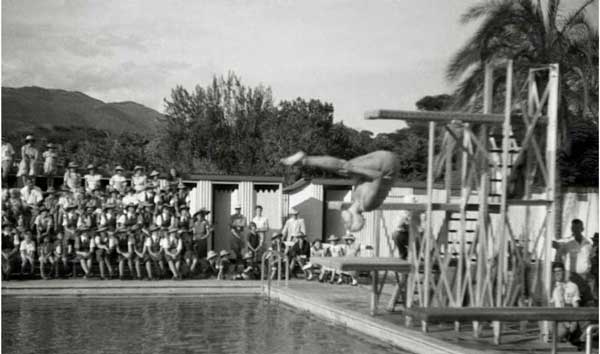
Ann Ross (USA) - diving at Umtali in 1954
The author - Rob McLean.

